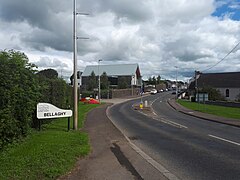For the village in County Sligo, see Bellaghy, County Sligo.
| This article includes a list of general references, but it lacks sufficient corresponding inline citations. Please help to improve this article by introducing more precise citations. (September 2013) (Learn how and when to remove this message) |
Bellaghy
| |
|---|---|
| Village | |
 Entering Bellaghy from Old Town Road, Seamus Heaney HomePlace in centre, August 2023 Entering Bellaghy from Old Town Road, Seamus Heaney HomePlace in centre, August 2023 | |
 | |
| Population | 1,063 (2001 Census) |
| District | |
| County | |
| Country | Northern Ireland |
| Sovereign state | United Kingdom |
| Post town | MAGHERAFELT |
| Postcode district | BT45 |
| Dialling code | 028 |
| Police | Northern Ireland |
| Fire | Northern Ireland |
| Ambulance | Northern Ireland |
| UK Parliament | |
| NI Assembly | |
| |
Bellaghy (from Irish Baile Eachaidh, meaning 'Eachaidh's town') is a village in County Londonderry, Northern Ireland. It lies north west of Lough Neagh and about 5 miles north east of Magherafelt. In the centre of the village (known locally as The Diamond) three main roads lead to Magherafelt, Portglenone and Toome. It had a population of 1,063 people in the 2001 Census and is within Mid-Ulster District.
Bellaghy is home to various historical landmarks, including a well-preserved 17th century fortified house, Bellaghy Bawn, which is now a museum. A Grade B+ thatched cottage is present in the Bellaghy outskirts. The village is also known as the birthplace, childhood home and resting place of poet Seamus Heaney (1939–2013), who won the Nobel Prize for Literature. There is an arts centre in the village dedicated to Heaney.
History
There had long been Gaelic settlements in this area. Archaeological evidence has been found in the village of a Gaelic ringfort.
In the early 17th century, Bellaghy became one of many towns planned, built and settled under the authority of the Vintners Company of London, as part of the English Plantation of Ulster. In 1622, according to a manuscript of a Captain Thomas Ash, Bellaghy consisted of a church, a castle, a corn mill and twelve houses.

During the Plantation, English colonials built a fortified house in the village. It had surrounding walls and two circular towers at opposite corners. Recent excavations have revealed that the fortified house was built on the site of a former Gaelic ringfort. During the 1641 rebellion the house was attacked by Irish rebels, but it remained intact. Many other houses in the village were burnt to the ground. Locally it was called "The Castle" and is located on Castle Street. The refurbished house was opened to the public in 1996 as Bellaghy Bawn. It is a museum featuring exhibitions on local history.
On 2 May 1922, during the Irish War of Independence, the Irish Republican Army launched an attack on Bellaghy Royal Irish Constabulary barracks - the IRA men gained access after the outer gate was mistakenly left unlocked while a 'farewell party' was being held inside for a retiring police officer. One RIC officer was killed and at least two others wounded. An IRA volunteer was also killed when he went to inspect a room and was shot 'through the woodwork' by a B-Special who had concealed himself behind a half-open door. The three other IRA volunteers subsequently withdrew, but were captured shortly afterwards.
Notable people
See also: Category:People from BellaghySeamus Heaney, who became a Nobel Prize-winning poet, was born as the eldest of nine children at Mossbawn, his family's farm in Bellaghy. He later lived in Dublin but is buried in the graveyard of St Mary's Catholic Church, Bellaghy. The village has an arts centre dedicated to him, known as the Seamus Heaney HomePlace. The centre features talks, poetry readings, and performances. It has exhibits of photographs, texts, and poems to show the influence of place on his language.
Others to hail from the village include World Outdoor Bowls champion Margaret Johnston, international footballer Sarah McFadden and Eurovision 2022 entrant for Ireland Brooke Scullion.
Two Bellaghy natives, Francis Hughes and his cousin Thomas McElwee, died participating in the 1981 Irish hunger strike during The Troubles. They were protesting at the treatment by the British and supporting political change in Northern Ireland. Other republicans from Bellaghy include former Irish National Liberation Army (INLA) leader Dominic McGlinchey.
2001 Census
Bellaghy is classified as a Village by the Northern Ireland Statistics and Research Agency (NISRA), i.e. with population between 1,000 and 2,250 people. On Census day (29 April 2001), there were 1,063 people living in Bellaghy. Of these:
- 31.4% were aged under 16 years and 12.7% were aged 60 and over
- 49.9% of the population were male and 50.1% were female
- 86.0% were from a Catholic background and 14.0% were from a Protestant background
- 4.6% of people aged 16–74 were unemployed
See also
References
- "Bellaghy, County Derry". www.placenamesni.org. Place Names NI. Retrieved 26 November 2018.
- Bellaghy Placenames Database of Ireland. Retrieved: 2013-09-01.
- ^ Roslyn Sulcas, "Ireland Celebrates the Life and Legacy of Nobel Prize-Winning Poet", New York Times, 17 October 2016
- ^ Wallace Clark (1967). Guns in Ulster. Belfast: Constabulary Gazette. pp. 62–63.
- Lawlor, Pearse. The Outrages: The IRA and the Ulster Special Constabulary in the Border Campaign. Mercier Press, 2011. pp.268-269
- "Margaret Johnston MBE | Bellaghy Historical Society". Retrieved 12 November 2019.
- Carter, William (8 February 2022). "Ireland: Five Things to Know About Brooke Scullion". escYOUnited. Retrieved 10 May 2022.
